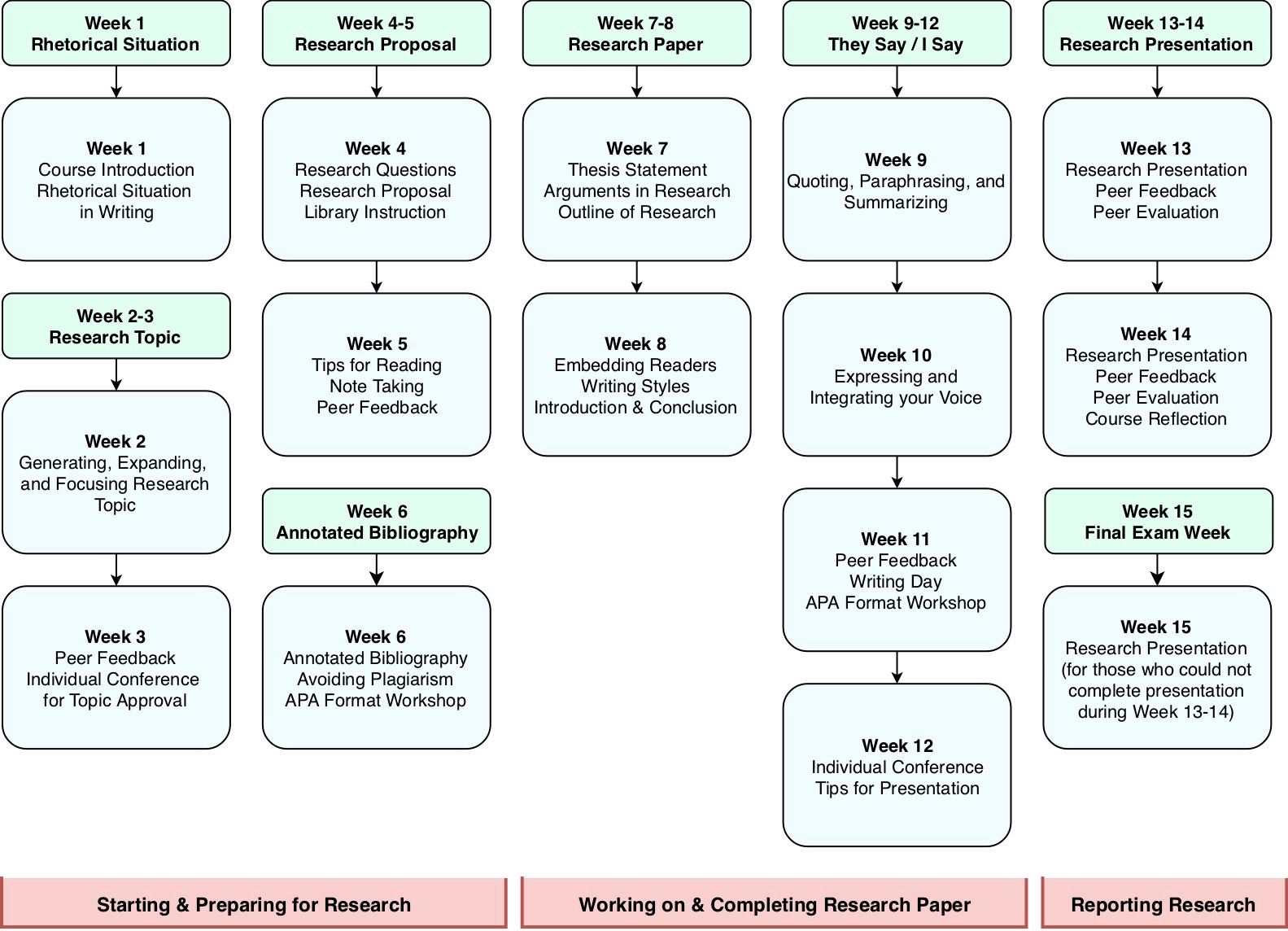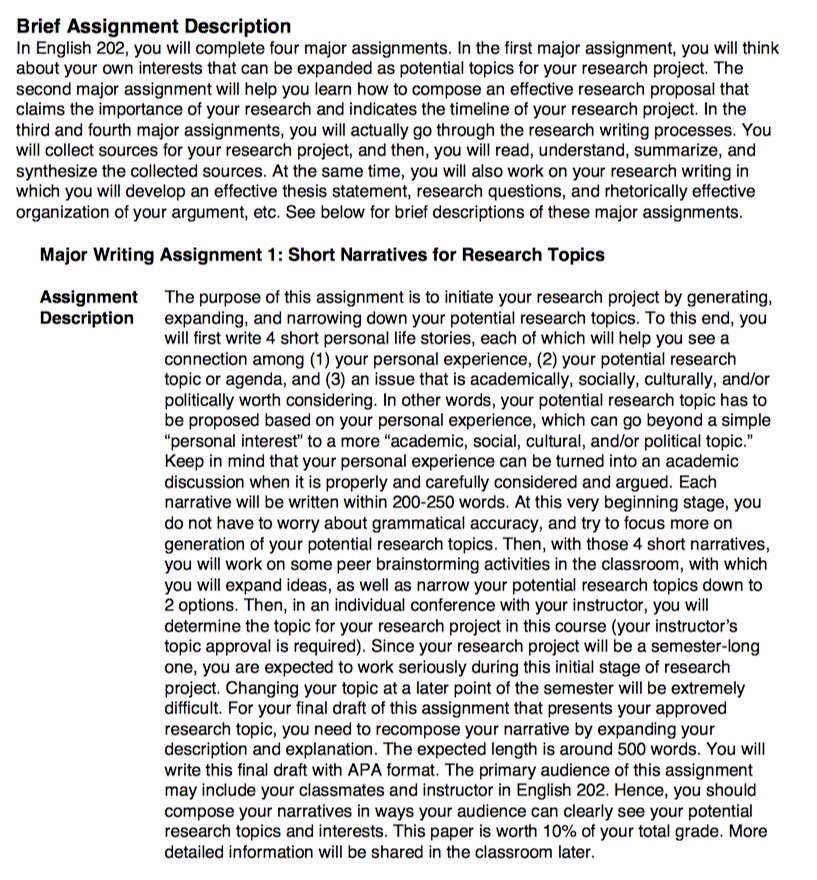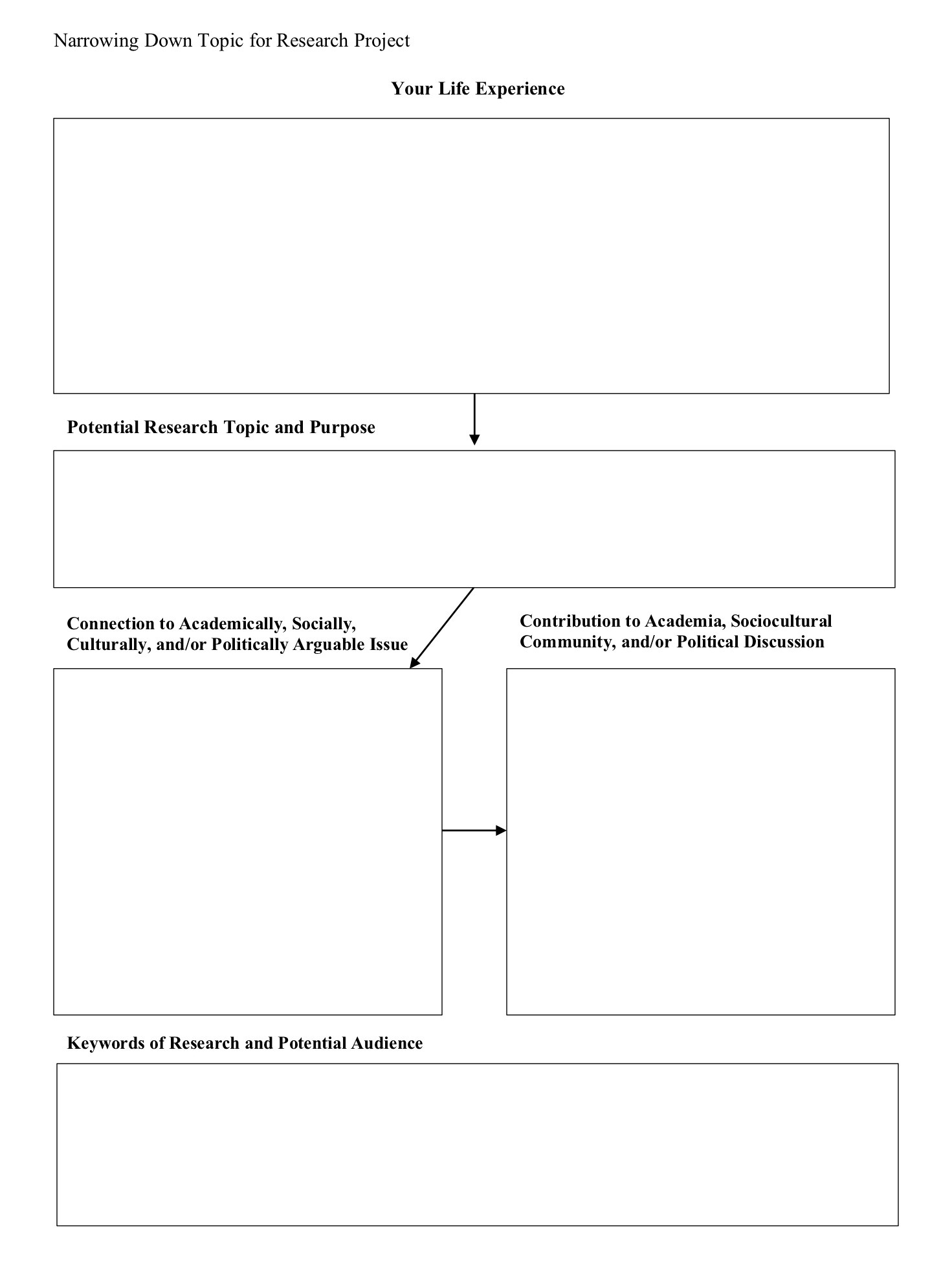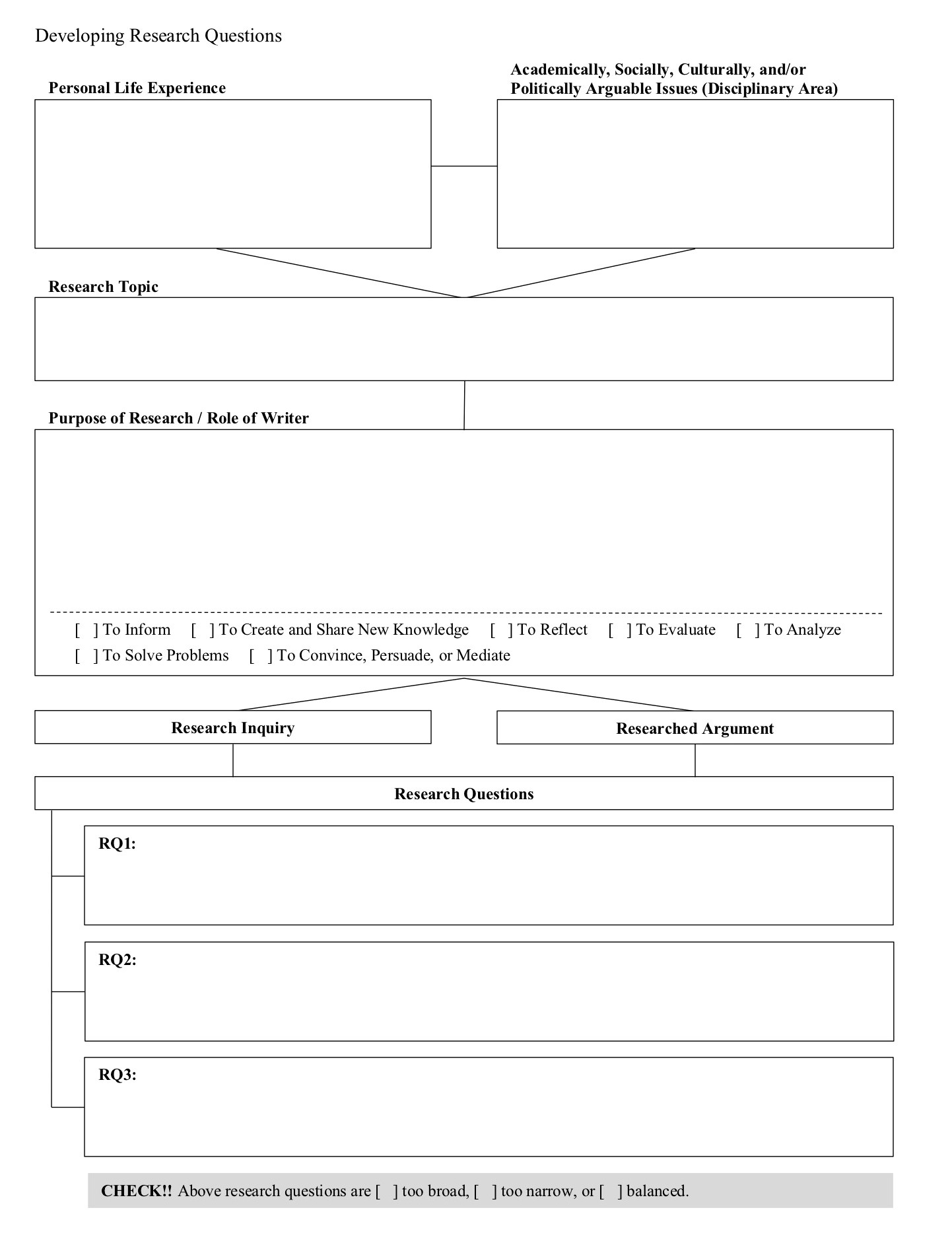- Home
- Various Articles - Learner awareness
- Pedagogical Applicability of Autobiographical Narrative in College Research Writing Class
Pedagogical Applicability of Autobiographical Narrative in College Research Writing Class
Jun Akiyoshi is a Ph.D. candidate in Composition and Applied Linguistics at Indiana University of Pennsylvania. He has various teaching experiences such as ESL literacy, Japanese as a foreign language, and English composition. His current research interests include autobiographical narrative and language teacher identity. Email: akiyoshi271@gmail.com
Introduction
An autobiographical narrative is widely acknowledged as a research tool in various disciplinary fields (cf. Freeman, 2008; Pavlenko, 2007), and yet it is worth paying attention to its pedagogical applicability in language and writing classrooms. In this paper, I will first describe an autobiographical narrative as a research method. Secondly, I will introduce some studies that used an autobiographical narrative as a part of their pedagogical approaches. Lastly, in sharing my own way of using an autobiographical narrative in a research writing class in the US college context, I will offer pedagogical implications for second language writing classes. The primary purpose of this paper is twofold: (1) to share my course design about how to use autobiographical narratives in a college writing classroom, and (2) to add a practical example to preexisting literature about pedagogical applications of autobiographical narratives as a meaningful writing task.
Autobiographical narrative as research method
Focusing on increasing attention to narrative inquiry, Connelly and Clandinin (1990) stated that the core reason to use narrative in educational studies is because “humans are storytelling organisms who, individually and socially, lead storied lives” (p. 2). The notion that human beings are storytellers is also mentioned in Murray (1991) in which he stated, “that all writing, in many different ways, is autobiographical, and that our autobiography grows from a few deep taproots that are set down into our past in childhood” (p. 67). As these scholars clearly described, each human being potentially has her/his own story to tell, and hence, the story is deemed to be a meaningful source of inquiry for scholars in various fields.
Life story narrative—which I label as autobiographical narrative in this paper—can be briefly defined as “the specific kind of text that results from the first-person interpretive reconstruction of either a life in its entirety or a significant portion of it” (Freeman, 2008, pp. 45-46). Due to its nature, autobiographical narrative as a method of inquiry can enable researchers to explore deeply complicated matters of human beings; therefore, it is frequently used to unveil highly intricate identity issues in various disciplinary fields such as applied linguistics (cf. Pavlenko, 2007) and TESOL (cf. Park, 2012, 2013). For instance, Pavlenko (2001) investigated multilingual writers’ identities through their autobiographical narratives. Furthermore, introducing one Chinese ESL learner’s autobiographical snapshots, Park (2012) examined how her language teacher identity was constructed and reconstructed through her experiences and interactions with others in China and in the United States. As seen in the above examples, an autobiographical narrative has seemingly established its position as a research method. Yet, it is worth shedding light on its applicability as a pedagogical tool in language and writing classrooms.
As it will be indicated in the following section of this paper, when an autobiographical narrative is assigned as a writing task, it can provide students with a meaningful opportunity to reflect on their own lives and lived experiences. Reflectively thinking about life, considering the meaning of certain lived experiences or expressing feelings and thoughts that derived from those experiences are very important for learners of either language or writing, for simplistic conflation between language accuracy and successful communication should be reconsidered. Indeed, as stated in Hanauer (2012), such opportunity can help make language and writing classrooms a more humanized space where teachers can position “the individual learner and her/his personal experience, history and social contextualization at the center of the learning experience” (2012, p. 108). An autobiographical narrative as a meaningful writing task is thus a valuable topic for language and writing teachers to take into consideration.
Autobiographical narrative in language and writing classrooms
In previous studies, autobiographical narrative as a pedagogical tool is actually adopted both in second language writing classes and in college composition classes. For instance, Park (2010) wrote about Cultural and Linguistic Autobiography Writing Project with which she aimed to help her adult ESL students have more meaningful and student-centered writing topics related to their lived experiences in the United States. Asking her students to write about (1) their family and themselves, (2) their learning experiences of language and culture, and (3) their overall learning outcomes from their autobiographies, Park (2010) found that autobiographical narratives were effective in teaching adult ESL learners. Indeed, she stated:
Providing opportunities for students to write about their lived experiences is a powerful pedagogical tool that not only empowers their ever-changing identities, but also guides them in continuously improving their English proficiency. Although this writing project was designed and implemented in adult ESL courses housed in a community college, it can be adapted for all grade, language, and content levels. By tweaking the writing prompts or including a variety of readings, the students can begin to write their way toward better understanding themselves as learners. (Park, 2010, p. 55)
More detailed outcomes of her autobiographical narrative writing task are introduced in her following research report (Park, 2013). In this study, Park (2013) reported that by working on an autobiography project, adult ESL writers could reflect on their goals of being and learning in the United States, and also could recognize themselves as legitimate writers with enhanced knowledge on academic writing. From this research, it is worth noting that autobiographical narratives can enable not only researchers to examine writers’ identities, but also writers themselves to explore their own identity issues. In this sense, it should be considered that autobiographical narratives have meaningful implications from both pedagogical and educational perspectives.
In addition to the language learning context, autobiographical narratives can also be used in a college composition classroom. For instance, Park (2015) shared the course design of her research writing course in which she aimed to help students raise awareness of diversity and social in/justice issues through their research projects (also see Park & Amevuvor, 2015). In her class, Park (2015) started students’ research by asking them to reflect on their own experiences related to diversity and social in/justice issues. More specifically, in the writing assignment that Park (2015) labeled as Diversity Autobiographical Narrative, she asked students to write about (1) their own understanding of diversity and social in/justice issues, (2) connections between their lives and diversity and social in/justice issues, (3) types of diversity and social in/justice issues that students experienced in their lives, and (4) potential research questions or topics informed by students’ own experiences of diversity and social in/justice issues. Although Park’s (2015) study did not necessarily focus on the use of an autobiographical narrative in a college research writing class, her study has an important implication that autobiographical narratives can be a valuable source for students to initiate student-centered research projects.
Such nature of an autobiographical narrative—which helps position students at the focus of their own learning—is also mentioned in Park’s (2010) Cultural and Linguistic Autobiography Writing Project. Additionally, it is important to note that autobiographical narratives can enable students to make connections between their personally significant experiences and broadly researchable issues at academic, social, cultural, and/or political fields. Hence, it should be acknowledged that the autobiographical narrative is a powerful pedagogical tool that is applicable in various educational contexts (e.g., ESL classrooms, college composition classrooms, language teacher education program, etc.).
Overall course design of my research writing class
Previous literature shows pedagogical applicability of autobiographical narratives in language and writing classrooms. This section introduces my course design in which I used autobiographical narratives to help students start their research projects. Unlike the research writing course in Park (2015), I did not set a specific theme in my course. However, following the principal concept of autobiographical narrative introduced in Park (2010), I also aimed to put students’ reflection and application of their lived experiences at the center of my course design. More detailed course information is described below.
As Figure 1 indicates, my research writing course was held over 15 weeks. Students were required to attend three class sessions in a week, and each class meeting lasted for 50 minutes. Although the course itself did not exclude international students, almost all the class participants were domestic students coming from the United States. Students were assigned two readings to learn about basic processes of research writing (Palmquist, 2015) and to learn about construction of researched argument (Graff & Birkenstein, 2014). Like Park’s (2015) research writing class, students in my class started their research writing from their autobiographical narratives so that they could construct research themes based on their own personal experiences and interests (Figures 2 and 3). As Figure 2 indicates, after the completion of the final draft of autobiographical narrative as an initial stage of research, students worked on other assignments that were generally required for research writing (e.g., proposal, annotated bibliography, outline of paper, etc.).


The following figure is a sample assignment guideline for the autobiographical narrative assignment (Figure 3). As Figure 3 shows, my autobiographical narrative assignment put emphasis on potential connections between students’ personally significant life experiences and their potential research topics at various realms (i.e., academic, social, cultural, and/or political issues). In this way, I attempted to create a student-centered research writing class. The autobiographical narrative assignment involved four stages: (1) composing four short narratives about students’ personally significant life experiences, (2) choosing the two most interesting and valuable stories for students themselves, (3) meeting with me to discuss and choose the narrative and relevant research topic, and (4) recompose the chosen narrative by adding more information. These four steps could help students recognize that their personal experiences were valuable enough, with which they could also construct researchable themes.

The above three figures present the overall course schedule and overall procedure of the research project. In the following section, I will explain how I scaffolded students’ composition of autobiographical narratives and their creation of research questions (Figures 4 and 5).
Lesson outline 1: Creating researchable topics from personal experiences
As indicated above, in my research writing class, it was essential for students to create connections between their personal life experiences and potential research topics. Additionally, after completing the autobiographical narrative assignment, students had to make tentative research questions for their projects. Therefore, two scaffolding processes were required before and after the autobiographical narrative assignment.
As the first scaffolding step, students were given the handout in Figure 4. This handout was created to help students visualize potential connections between their lived stories and potential researchable topics. Hence, completing four handouts could indicate that students would have four potential research themes that were derived from their personal life experiences. In the classroom, students were given one physical copy for practice. Furthermore, a digital copy was also uploaded on the online learning support system of the college (i.e., Desire2Learn) so that students could make other physical copies by themselves.
In the class session, I explained the purpose of this handout and then demonstrated how to use it. After checking whether students had questions about the handout, I gave them ample amount of the class period to work on the handout. After that, based on what they wrote on the handout, students started to work on the autobiographical narrative assignment. More specific steps for this assignment is already described above.

Lesson outline 2: Creating research questions from the chosen personal experience
After choosing one story and determining a potential research topic, students were asked to create tentative research questions, which they hoped to delve into throughout their research projects. In order to help students, I gave the handout in Figure 5 in the classroom. Like the one in Figure 4, this handout could also help students visually see connections from their significant life experience, research topic and then to potential research questions. One physical copy was shared in the classroom, and a digital copy was also shared online in case students wanted to rework the handout outside of the classroom.
For this scaffolding process, in the classroom, I explained the purpose of this handout and then demonstrated how to use it for students’ research projects. Students were then given the rest of the class period to work on this handout. Since creating well-balanced research questions that are not too broad or narrow is a challenging task, I carefully walked around the classroom and left comments on students’ research questions.

Figures 4 and 5 indicate the essential scaffolding processes to support students’ (1) construction of autobiographical narratives for subsequent research projects, and (2) creation of research questions. Since the center of learning and research was the students themselves, these two processes were very important. Indeed, students were seemingly enjoying their research projects that were originally derived from their personal experiences and interests. It is hence worth taking into consideration for teachers to employ an autobiographical narrative in their own language or writing classrooms, especially when the courses include a research writing assignment.
Pedagogical implications for second language writing class
With this paper, I have introduced how I used autobiographical narratives in a research writing class in the US college context. Although my course mainly included domestic students of the United States, the same pedagogical approach should be applicable in second language writing classes. As Park (2013) indicated, autobiographical narratives can help second language writers be aware of their own motivation or desire to study, as well as help them improve academic writing skills. Similarly, through writing autobiographically, learners can learn how to express their experiences, feelings, and thoughts in ways that they can make sense to their potential audience. If the second language writing class assigns research writing, autobiographical narratives can also help learners have meaningful opportunities to make connection between their lived experiences and their academic, sociocultural, and/or political interests, which in turn make learners themselves as the catalyst of their own desire to learn. In this sense, as seen in previous literature, autobiographical narratives can be a powerful pedagogical approach in both language and writing classrooms. Especially in the language classroom, such writing tasks can make students’ learning processes more humanized, going beyond simple conflation among linguistic accuracy, successful communication and also academic achievement.
Conclusion
Autobiographical narratives offer a very meaningful opportunity for students to communicate with themselves, which can provide them with a variety of benefits. Students’ own exploration of identities can be one, and their improvement of writing performance can be another. Since autobiographical narratives should have more possibilities as a meaningful writing assignment, it is expected that more lesson ideas like this paper will be shared among teachers of language and writing.
References
Connelly, F. M., & Clandinin, D. J. (1990). Stories of experience and narrative inquiry. Educational Researcher, 19(5), 2-14.
Graff, G. & Birkenstein, C. (2014). “They Say / I Say”: The Moves that Matter in Academic Writing (3rd Ed.). New York: W.W. Norton & Company.
Freeman, M. (2008). Autobiography. In L. Given (Ed.), The Sage Encyclopedia of Qualitative Research Methods (pp. 45-48). Thousand Oaks, CA: Sage Publications, Inc.
Hanauer, D. I. (2012). Meaningful literacy: Writing poetry in the language classroom. Language Teaching, 45(1), 105-115.
Murray, D. M. (1991). All writing is autobiography. College Composition and Communication, 42(1), 66-74.
Palmquist, M. (2015). The Bedford Researcher with 2016 MLA Update (5th Ed.). Boston, MA: Bedford.
Park, G. (2010). Meaningful writing opportunities in the community college: The cultural and linguistic autobiography writing project. In S. Kasten (Ed.), Effective Second Language Writing (pp. 51-55). Alexandria, VA: TESOL, Inc.
Park, G. (2012). "I am never afraid of being recognized as an NNES": One teacher's journey in claiming and embracing her nonnative-speaker identity. TESOL Quarterly, 46(1), 127-151.
Park, G. (2013). ‘Writing is a way of knowing’: Writing and identity. ELT Journal, 67(3), 336-345.
Park, G. (2015). Raising awareness of diversity and social (in)justice issues in undergraduate research writing: Understanding students and their lives via connecting teaching and research. Journal of Pedagogic Development, 5(1), 65-72.
Park, G., & Amevuvor, J. (2015). ‘If you learn about these issues, you're going to learn... more about yourself and things that you come in contact with every day’: Engaging undergraduate students in meaningful literacy in a research writing course. Journal of Pedagogic Development, 5(2), 50-68.
Pavlenko, A. (2001). “In the world of the tradition, I was unimagined”: Negotiation of identities in cross-cultural autobiographies. International Journal of Bilingualism, 5(3), 317-344.
Pavlenko, A. (2007). Autobiographic narratives as data in applied linguistics. Applied Linguistics, 28(2), 163-188.
Please check the Teaching Advanced Students course at Pilgrims website.
Please check the How to be a Teacher Trainer course at Pilgrims website
Learner Autonomy in a South Korean Educational Context: An Experiment Using Action Research
Andrew Griffiths, South KoreaPedagogical Applicability of Autobiographical Narrative in College Research Writing Class
Jun Akiyoshi, USA